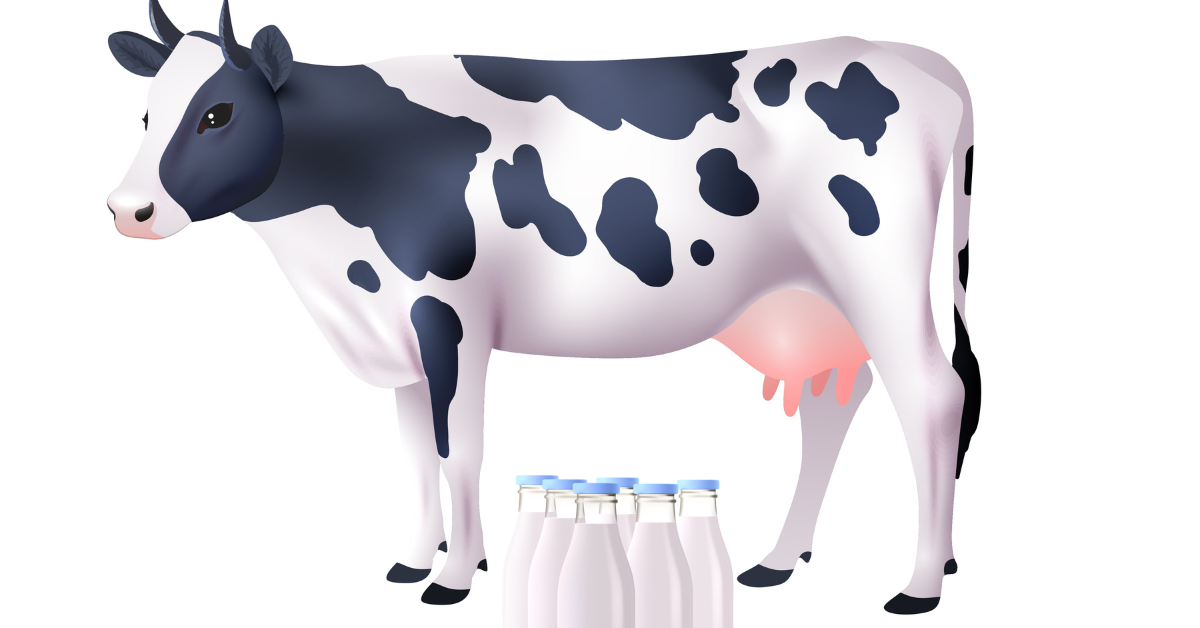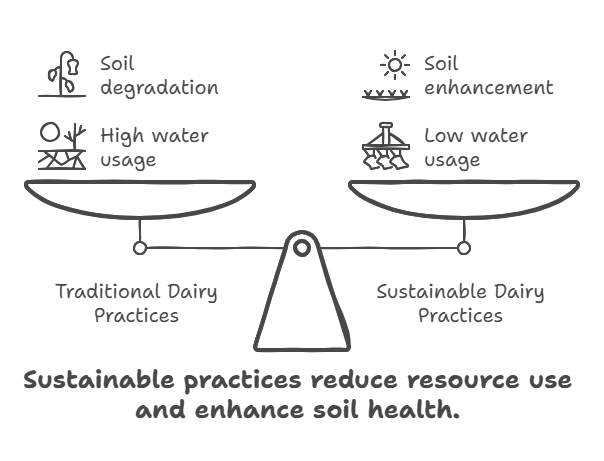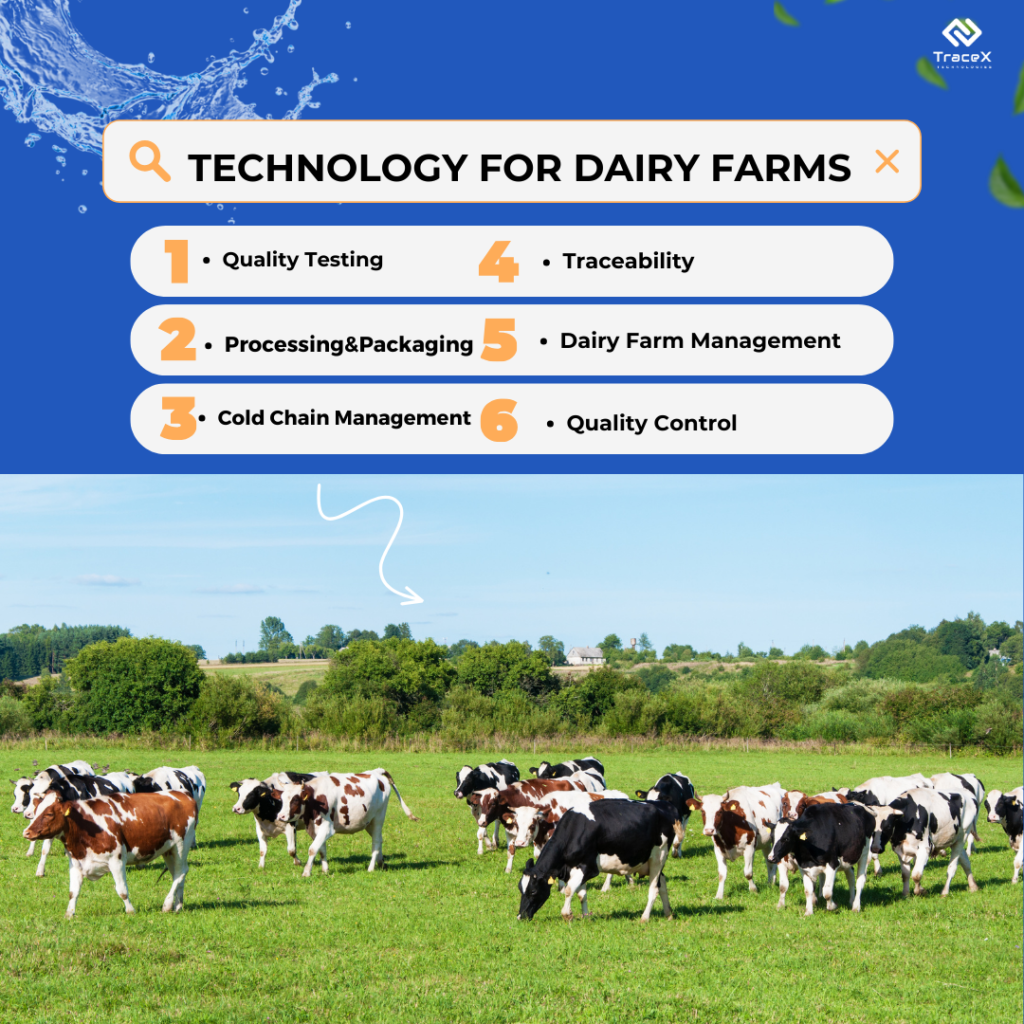Contact: +91 99725 24322 |
Menu
Menu
Quick summary: Discover how sustainable dairy farming practices are shaping the future of milk production. Learn about innovative solutions, benefits, and how technology drives sustainability in the dairy industry.

Milk has been a cornerstone of human nutrition for centuries, but its production comes with a heavy environmental cost. With increasing awareness of climate change and resource depletion, the dairy industry is under mounting pressure to adopt greener practices. Traditional dairy farming contributes significantly to greenhouse gas emissions, water overuse, and biodiversity loss.
Sustainable dairy farming is a transformative approach that prioritizes environmental responsibility, animal welfare, and long-term economic viability
Consumers are demanding transparency and eco-conscious products, while dairy producers grapple with the challenge of meeting these expectations without compromising profitability. What if the future of milk didn’t just nourish people but also nurtured the planet? By rethinking how we produce milk, the industry has the opportunity to create a more sustainable future for farmers, consumers, and the planet alike.
Key Takeaways
When we talk about sustainable dairy farming, we mean a way of producing milk that balances the needs of the environment, the animals, and the people involved. It’s about finding smarter ways to produce milk while protecting the planet, treating animals well, and supporting farmers’ livelihoods.
At its core, sustainable dairy farming focuses on three key principles:
It’s a holistic approach that looks beyond profit to consider the long-term well-being of everyone and everything involved.
Dairy farming, as it stands, is resource-intensive. Here’s why change is crucial:

By switching to eco-friendly practices, dairy farmers can reduce their carbon footprint, cut costs by using resources more efficiently, and create a product that consumers trust. It’s not just about saving the planet—it’s about securing the future of milk production for generations to come.
Sustainable dairy farming is about adopting smarter practices that benefit the environment, the animals, and the farmers themselves. Here are some of the most effective approaches to make milk production more eco-friendly and efficient:
Imagine being able to monitor exactly how much water or feed your cows need—without guessing. Thanks to IoT devices and sensors, farmers can now optimize the use of water, energy, and feed, reducing waste and saving money. For example, automated feeders deliver the right amount of food to each cow, and moisture sensors in the soil ensure only the necessary water is used.
Many dairy farms are switching to renewable energy sources like solar panels, wind turbines, or biogas systems that convert manure into energy. Not only does this cut energy costs, but it also reduces reliance on fossil fuels. Biogas, in particular, is a game-changer—it turns a waste product into a renewable resource while cutting methane emissions from manure storage.
Cows produce methane, a potent greenhouse gas, during digestion. However, feeding them sustainable diets—such as adding seaweed or specially formulated supplements—can significantly reduce these emissions. These practices are great for the planet and improve the overall health of the herd, leading to better milk yields.
Healthy, stress-free cows produce better milk. Ensuring proper living conditions, such as spacious barns, clean bedding, and access to pastures, is essential. Advanced health monitoring systems track vital signs and alert farmers to any issues early, so cows can receive care immediately. Practices like stress-free milking routines also contribute to the animals’ overall well-being.
Healthy soil is the foundation of sustainable farming. Techniques like crop rotation, planting cover crops, and reducing chemical fertilizers improve soil quality and prevent erosion. Similarly, water conservation strategies—such as rainwater harvesting and recycling water for irrigation—help farmers reduce their water footprint while maintaining productivity.
These innovations not only lower the environmental impact of dairy farming but also help farmers save money, increase efficiency, and meet growing consumer demand for ethical and sustainable products. It’s about creating a farming system that works for today without compromising tomorrow.
Sustainable dairy farming helps to significantly reduce the carbon footprint of milk production. Practices like renewable energy use, methane-reducing feed, and efficient water management ensure that farming works in harmony with the environment. By preserving biodiversity through better soil and land management, farmers also protect natural ecosystems. It’s a step toward leaving the planet healthier for the next generation.
Imagine a dairy farm where every drop of water is recycled, and every bit of manure is turned into energy—it’s possible and happening in sustainable farms today!
Sustainability pays off in the long run. Renewable energy, precision agriculture, and better feed management lower operational costs over time. Moreover, as consumers demand eco-friendly products, sustainable farmers can command premium prices. Governments and organizations also provide subsidies and incentives for adopting green practices, adding more financial value to the equation.
Think of it this way: by investing in sustainability today, farmers set themselves up for financial resilience tomorrow.
Consumers care deeply about where their milk comes from. By adopting sustainable practices, dairy farmers can win consumer trust by ensuring their products are ethically produced. It also aligns farms with Environmental, Social, and Governance (ESG) goals—a must for businesses looking to partner with socially responsible companies.
When consumers see a product labeled as sustainable, they’re not just buying milk—they’re supporting a story of care for the planet, animals, and people.
In a competitive dairy market, sustainability is a powerful differentiator. Brands that commit to eco-friendly practices stand out, attract loyal customers, and open doors to new markets. With sustainability becoming a key purchasing criterion, adopting these practices can help dairy businesses remain relevant and competitive.
Embracing sustainable dairy farming isn’t just about keeping up with trends; it’s about creating a farming system that’s better for the environment, more profitable for farmers, and more ethical for consumers. It’s about producing milk that everyone can feel good about—now and in the future.
Technology is transforming the way we farm, and dairy is no exception. With growing demands for sustainability, innovative tools are helping farmers make smarter, greener decisions . Traceability in the dairy supply chain ensures transparency, from farm to consumer, by tracking sustainability practices and resource usage. This enables dairy producers to demonstrate environmental responsibility, improve animal welfare, and meet consumer demand for ethically sourced products.
Have you ever wondered where your milk comes from and how it’s produced? Blockchain makes it possible to answer those questions with certainty. By creating a digital ledger that records every step of the milk production process—from farm to fridge—blockchain ensures transparency and trust.
For example, consumers can scan a QR code on a milk carton to see details about the farm it came from, the feed given to the cows, and even the sustainability practices used. For dairy farmers, this level of traceability builds trust with customers and ensures compliance with regulations.
Milk Mantra, a dairy processing company, integrated TraceX’s blockchain traceability platform into its operations to enhance transparency and traceability throughout the dairy value chain. By establishing end-to-end traceability from various collection points, the company aimed to democratize the supply chain, ensuring greater accountability, quality control, and sustainability. This initiative allowed Milk Mantra to provide consumers with verified, transparent information about the origin and journey of their dairy products, while also supporting ethical sourcing and sustainable practices.
Artificial Intelligence (AI) and the Internet of Things (IoT) are game-changers for dairy farms. IoT devices like sensors and smart collars provide real-time data about livestock health, milk production, and resource usage. AI then analyzes this data to offer actionable insights.
Imagine being alerted when a cow isn’t eating enough or when water use on the farm exceeds sustainable limits. These technologies allow farmers to optimize feed, conserve water, and even predict potential health issues in livestock—all of which reduce costs and environmental impact.
Platforms like TraceX are revolutionizing how farmers and businesses track and report on their sustainability efforts. These tools simplify compliance with sustainability standards, making it easier for farmers to show how they’re reducing their carbon footprint or improving animal welfare.
For example, a farmer can use a platform like TraceX to measure and report greenhouse gas emissions from their operations. This not only ensures compliance with environmental regulations but also helps farmers qualify for sustainability certifications that can fetch premium prices in the market.
In the journey toward sustainable dairy farming, technology is a powerful ally. It makes farming more efficient, environmentally friendly, and transparent, benefiting everyone—from farmers to consumers.
As these tools become more accessible, they’re turning what once seemed like daunting challenges into manageable solutions, ensuring a brighter, greener future for the dairy industry.
The Technoserve Dairy initiative focuses on strengthening milk traceability systems to ensure high-quality milk procurement while also building the capacity of farmers and entrepreneurs. By enhancing these systems, the project aims to drive sustainable development within the dairy sector, ensuring better practices, higher quality, and long-term benefits for all stakeholders involved.

Sustainable dairy farming comes with unique challenges, from ensuring environmental compliance to optimizing resource use and improving transparency. TraceX’s traceability and sustainability platform offers innovative solutions to tackle these challenges effectively:
TraceX enables end-to-end traceability of milk and dairy products, from farm to consumer. By integrating blockchain technology, it creates an immutable record of every step in the production process.
The platform captures and monitors critical sustainability data, including greenhouse gas emissions, water usage, and waste management.
TraceX supports the integration of animal welfare standards by tracking livestock health, housing conditions, and feed quality.
TraceX automates compliance processes by generating reports that align with sustainability regulations and certifications.
By creating a transparent supply chain, TraceX allows brands to communicate their sustainability initiatives directly to consumers.
The future of milk lies in sustainable dairy farming practices that balance environmental care, economic viability, and social responsibility. Embracing innovations like renewable energy, precision farming, and animal welfare initiatives ensures a thriving dairy industry that meets growing consumer demands while safeguarding the planet. By adopting these practices, stakeholders can create a more transparent, ethical, and sustainable supply chain that benefits everyone—from farmers to consumers.
Sustainable dairy farming involves environmentally friendly, socially responsible, and economically viable practices. It includes reducing emissions, conserving resources, and improving animal welfare to create a balanced dairy supply chain.
Technology such as blockchain, IoT, and AI helps monitor livestock health, optimize resource use, and ensure transparency in the supply chain, making sustainability measurable and achievable.
Sustainable dairy farming reduces environmental impact, improves farm profitability, and builds consumer trust. It also aligns with global goals like reducing greenhouse gas emissions and conserving biodiversity.
